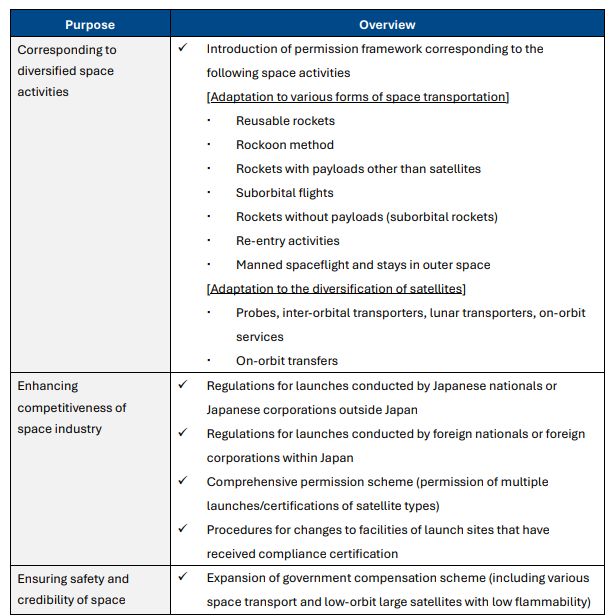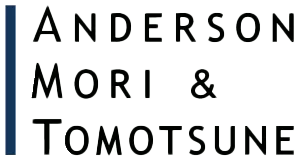- within Technology topic(s)
Part 1: An Overview of the Review and New Rules for Reusable Rockets and Suborbital Flights
1. Introduction
The Act on Launching and Managing Satellites (hereinafter referred to as the "Space Activities Act") is the cornerstone of space business regulation in Japan, having been enacted in 2018. This legislation was the first in Japan to establish a framework for licensing and other regulatory mechanisms concerning private space enterprises. However, at the time of its enactment, the scope of the space business it envisaged was limited, primarily focusing on communication satellites and satellites for remote sensing.
Since then, the private space sector has rapidly advanced, becoming more sophisticated and diverse. Numerous countries have been revising their space legislation to keep pace with these rapid developments. In Japan, pursuant to Article 5 of the supplementary provisions of the Space Activities Act, which mandates a review every five years, active discussions have been underway since September 2024 within the Subcommittee on the Review of the Space Activities Act (the "Subcommittee"). This Subcommittee was established under the Cabinet Office's Space Policy Committee to conduct the first review since the law's enactment.
In January 2025, the Subcommittee published the "Basic Approach for the Review of the Space Activities Act: Interim Summary" (hereinafter referred to as the "Interim Summary"), which encapsulates the discussions held thus far. Further discussions are anticipated, building on this Interim Summary, leading to the release of the final summary of discussions and the submission of a bill to amend the Space Activities Act.
The content addressed in the Interim Summary indicates the future direction of Japan's space legislation and is considered noteworthy for stakeholders involved in the private space sector. Therefore, in this article and the next, we will provide a brief overview of what is addressed in the Interim Summary.
2. Overview of the Interim Summary
In the Interim Summary, the following points are listed as issues to be discussed in the current review of the Space Activities Act:


In this article and the next, we will particularly focus on the regulations being considered for introduction aimed at addressing the diversification of space business and at providing explanations for the necessity of the proposed regulations
3. New Rules Regarding Reusable Rockets and Suborbital Flights
The interim report aims to establish detailed regulations to appropriately govern the various types of space businesses in response to their recent diversification. This article will first address the rules concerning reusable rockets and suborbital flights.
3.1. Reusable Rockets
Previously, rockets used for launching satellites were typically "disposable." Having said that, recent advancements have resulted in the commercialization of reusable rockets, which involves the safe descent and recovery of the first stage (reusable stage) that separates after reaching a certain altitude post-launch.
The current Space Activities Act does not include provisions for examining the safety of the reusable stage during its recovery under the launch permit for satellites. Consequently, the interim report suggests that specific system designs will be considered to establish necessary regulations, such as involving standards for ensuring safety around the descent path and landing/recovery sites of reusable rockets.
3.2. Rockoon Method
The rockoon method involves launching a rocket from a balloon that has ascended to a certain altitude. The current Space Activities Act does not include balloon launches under its permit requirements. The interim report proposes to establish regulations equivalent to existing launch permits for satellite launches using the rockoon method.
3.3. Suborbital Flights
The launches mentioned in the aforementioned sections primarily assume that rockets reach outer space. Contrarily, we have witnessed a global trend towards the practical application of flights that reach higher altitudes than aircraft but return to Earth without reaching orbital paths. These are known as "suborbital flights," which are expected to be used for high-speed point-to-point transportation, space tourism, and microgravity experiments in the future.
Currently, suborbital flights are considered outside the scope of launch permits under the Space Activities Act, as they do not either reach orbital paths or release satellites. The discussion is ongoing about whether such suborbital flights should also be included under the Space Activities Act's permit requirements.
On the one hand, it has been pointed out that it may in practice be difficult to distinguish between suborbital vehicles and "aircraft" under the Japanese Aviation Act to the degree necessary for applying separate regulations. On the other hand, it is argued that, regarding suborbital vehicles that are still in development, these should not be regarded as the same as "aircraft," which already have established flight technologies and strict safety standards. In their view, applying to suborbital flights regulations that are comparable to those applying to aircraft could hinder the development of this emerging technology.
With this dilemma in mind, the interim report states that "it is necessary to pursue a concrete examination of the possibility of regulating suborbital flights under the Space Activities Act, and in doing so, it is necessary to carefully hold discussions with the relevant parties, including foreign authorities, domestic and international regulatory authorities, and private companies," although the report does not trace out any specific directions for such future rules.
4. Conclusion
In this article, we have provided an overview of the new rules concerning reusable rockets and suborbital flights as outlined in the interim report. In the next article, we plan to address current discussions being held on the formulation of new rules for re-entry and manned flights.
The content of this article is intended to provide a general guide to the subject matter. Specialist advice should be sought about your specific circumstances.



